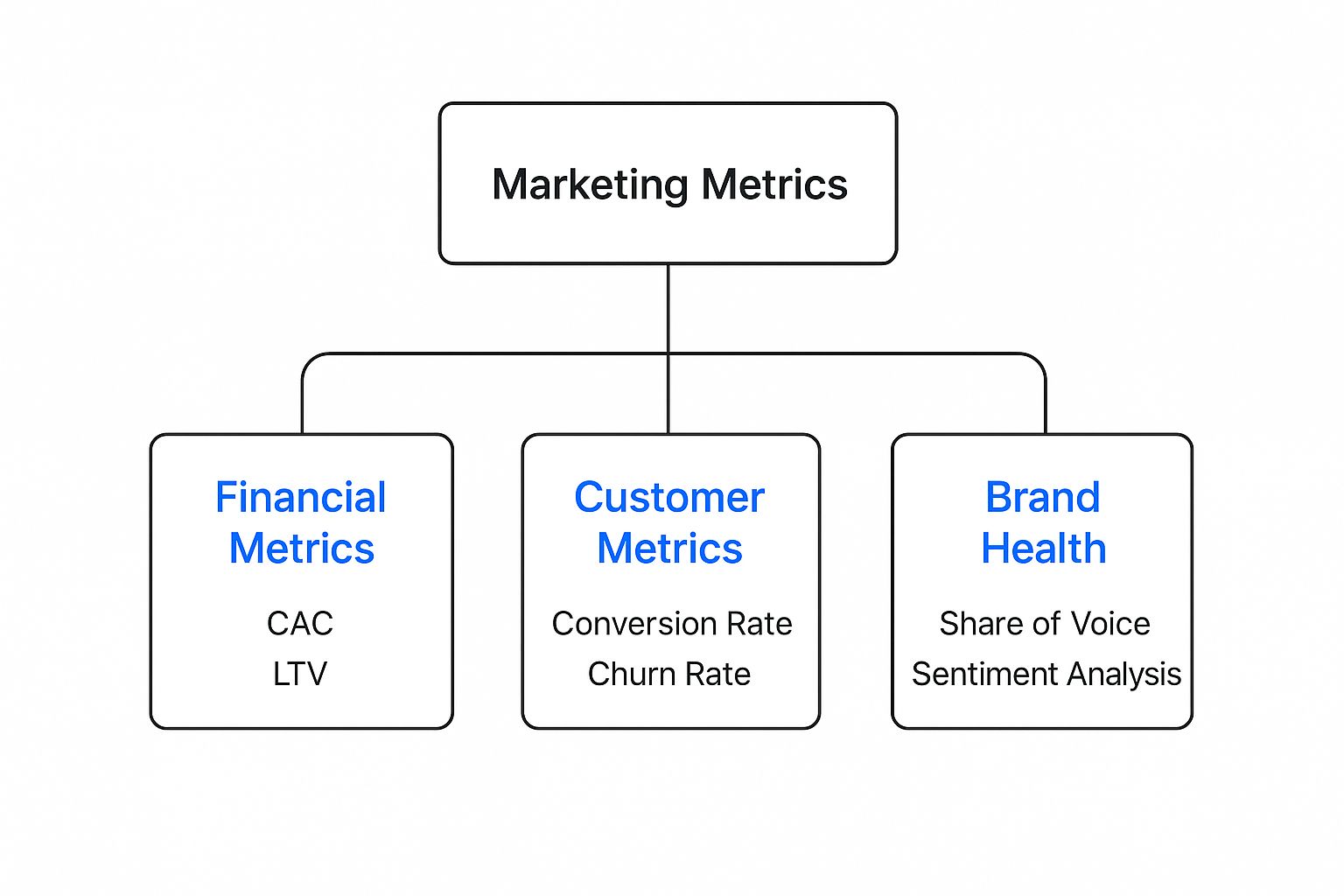So, what exactly is marketing effectiveness measurement? Think of it as the process of figuring out how your marketing efforts are actually contributing to real business goals, like boosting revenue or grabbing more market share. It’s about moving beyond simple metrics like clicks and likes to understand the true impact and return on investment (ROI) of your campaigns.

Imagine your marketing budget is the fuel for a ship on a long journey. You can burn through that fuel at a shocking rate, but without a navigation system, you might just be sailing in circles. Marketing effectiveness measurement is that navigation system.
It’s the tool that tells you whether you're on course to your destination—your business goals—or if you're just drifting aimlessly in the open sea. Without it, you’re just guessing, hoping that your social media posts, email blasts, and paid ads are somehow pushing the needle. That’s not just inefficient; it’s a fast track to wasted money and missed opportunities.
The biggest trap for many marketing teams is getting fixated on "vanity metrics." These are the numbers that look impressive in a report but have almost no connection to the health of the business.
A thousand likes on an Instagram post feels great, but it doesn't pay the bills. The real shift happens when you stop asking, "How many people saw our ad?" and start asking, "How did that ad influence sales and customer loyalty?"
This change in mindset is everything. It forces you to connect your day-to-day marketing activities directly to the outcomes that matter. To really grasp why this is your growth compass, you have to dig into quantifiable results. For a deeper dive, check out this ultimate guide to measuring marketing ROI.
Meaningful measurement focuses on metrics that reflect genuine business growth, such as:
Truly effective measurement depends on solid analytics to turn raw data into smart decisions. The right blend of marketing and analytics helps you justify your budget, prove your team's value to the higher-ups, and make better calls on where to invest next. You can learn more about the impact of marketing and analytics on marketing in our detailed guide.
When you adopt a measurement-first mindset, your marketing team stops being seen as a cost center. Instead, it becomes a predictable, data-driven growth engine for the whole company.

For a long time, the marketing world ran on a simple, yet deeply flawed, idea: last-click attribution. This model gave 100% of the credit for a sale to the final touchpoint a customer had before they converted. It was easy to track and even easier to report, but it told a dangerously incomplete story.
Imagine a customer’s journey is like a relay race. They might see a social media ad (the first runner), read a blog post (the second), and get an email (the third) before finally clicking a Google ad to buy. Last-click attribution ignores the first three runners and pins the gold medal on the last one.
This created a warped view of performance, overvaluing channels that are good at closing deals (like branded search) while completely ignoring the channels that build awareness and trust in the first place. To really understand what works, we had to evolve. You can get a deeper look at different models in our guide on First Click vs. Last Click Attribution.
The biggest problem with older models is that they only show correlation, not causation. They tell you which channels were present on the path to a sale, but not whether those channels actually caused the sale to happen. This is where the idea of incrementality changes the game.
Incrementality measurement answers one simple but powerful question:
What would have happened if this specific marketing activity never ran at all?
By answering this, you can finally isolate the true, causal impact of your efforts. You’re no longer just tracking clicks; you’re measuring the lift your marketing provides over what would have happened organically. It’s the difference between a customer who was already going to buy your product anyway and one who bought it because they saw your ad.
So, how do you measure something that didn't happen? The go-to method is running controlled experiments, often called lift studies.
Let's say a shoe brand wants to know if a new Facebook video ad campaign is actually effective. Instead of showing the ad to everyone, they split their audience into two groups:
After the campaign runs, the brand compares the sales from both groups. If the test group generated $50,000 in sales and the control group generated $30,000 on its own, the incremental lift from the ad campaign is $20,000. That’s the real value the campaign created.
This scientific approach gives you definitive proof of an ad's impact, moving far beyond simple click and conversion counts.
Today, the most advanced ways to measure marketing effectiveness are Incrementality Testing and Media Mix Modeling (MMM). While MMM gives you a top-down, strategic view of how all your channels work together over time, incrementality provides bottom-up, causal proof for specific campaigns.
The concept of incrementality has become especially popular as privacy changes make individual tracking much harder. For example, a major global sports brand used Google's Ads Data Hub to run tests by creating test and control groups in similar cities. This helped them pinpoint the actual value each channel added, giving them clear direction for their budget.
But these advanced methods aren't without their own hurdles. Running sophisticated lift studies and building MMMs has historically been expensive and complex, often requiring data science teams and big budgets. Plus, the best native tools are typically offered by platforms like Meta and Google, which can make cross-channel analysis a real headache. This is exactly the gap that specialized platforms are now starting to fill.
Knowing which metrics to track is one thing. But turning that raw data into actual intelligence? That's where a well-built dashboard comes in. Think of it as your mission control, giving you a real-time, at-a-glance view of your marketing engine's health. It helps you see what’s working, what isn’t, and where to put your money—without drowning in a sea of spreadsheets.
The trick is to move beyond a random collection of numbers. You need to group your metrics into logical categories that tell a complete story, connecting top-of-funnel brand activities all the way down to bottom-line results.
This infographic breaks it down into a simple hierarchy with three core categories. Together, they give you a complete picture of your performance.

This structure ensures you’re not just chasing immediate financial returns. You’re also keeping an eye on the customer behaviors and brand perceptions that fuel sustainable, long-term growth.
These are the numbers your CFO actually cares about. They draw a straight line from marketing spend to revenue and profit, giving you undeniable proof of your team's value. In short, they're the final score of the game.
Two of the most important financial metrics are:
Keeping these metrics front and center helps you answer the ultimate question: is our marketing spend actually driving profitable growth? It reframes the conversation from marketing being a "cost center" to a powerful investment. For a deeper dive, check out our complete guide to building a marketing performance dashboard.
While financial metrics show the final result, customer-centric metrics track the behaviors that lead to that result. They’re the leading indicators that tell you how well you’re guiding people through their buyer’s journey.
These metrics are the heartbeat of your marketing funnel. A steady, strong rhythm indicates a healthy flow of engagement, while irregularities can signal friction points that need immediate attention.
Key metrics in this category include:
Tracking these numbers gives you a ground-level view of what your customers are actually doing, so you can optimize their journey and keep them coming back.
Brand health metrics can feel a bit "softer," but they are the bedrock of long-term success. They measure your brand’s reputation and visibility in the market—the very things that build the trust needed to make a sale. A strong brand creates a protective moat around your business that competitors simply can't cross.
A couple of important brand health indicators to watch are:
A truly effective measurement strategy balances all three of these pillars. Financial metrics prove your value, customer metrics guide your day-to-day optimizations, and brand metrics ensure you’re building an asset that lasts.
Once you have your key metrics lined up, the next step is to give them a home inside a structured framework. Think of a framework as the lens on a camera. Some lenses, like a wide-angle, give you a sweeping view of the entire landscape. Others, like a zoom lens, let you zero in on the tiniest details. The right marketing effectiveness measurement framework depends entirely on what you’re trying to see.
Picking the right one is a big deal because it’s the rulebook for how you assign credit for conversions. It decides which of your marketing efforts gets the trophy. Without a clear framework, you're just collecting a bunch of data points with no story to tie them together.
The most common starting point for any measurement strategy is attribution modeling. These models are all about answering one simple question: which touchpoints get credit when someone buys something? The most basic models give you straightforward—if sometimes incomplete—answers.
Let's look at the two most common single-touch models:
While they’re easy to understand, these models paint a pretty limited picture of the customer journey. It’s like giving all the credit for a championship win to either the player who scored the first point or the one who scored the last, totally ignoring the team's effort in between.
To get a more realistic view, most marketers turn to multi-touch attribution (MTA). Instead of putting all the focus on a single interaction, MTA models distribute credit across multiple touchpoints in the customer's journey. This gives you a much richer understanding of how different channels work together.
Multi-touch attribution acknowledges that the customer journey is rarely a straight line. It’s a series of interconnected moments, and a smart framework gives credit where it's due, rewarding both the channels that start the conversation and those that close the deal.
There are several ways to spread this credit, each offering a different perspective:
Getting a handle on these different approaches is the first step toward building a more accurate picture of campaign performance. For a more detailed breakdown, you can learn more about marketing attribution in our comprehensive guide.
Attribution models are fantastic for a bottom-up, tactical view of your digital channels. But what if you need a top-down, strategic perspective? That’s where Marketing Mix Modeling (MMM) comes in. MMM is the wide-angle lens of measurement.
Instead of tracking individual user journeys, MMM uses statistical analysis on aggregated data (like weekly sales and ad spend) over a long period—often several years. It helps you understand the total impact of your entire marketing mix, including things that attribution can't track, such as:
MMM answers big-picture questions like, "For every dollar we put into TV ads, what’s the overall return on sales?" It’s a powerful tool for high-level budget allocation and long-term strategic planning. As you develop your framework, it's also smart to consider how to measure brand equity, which gives you another long-term view of your marketing's lasting impact.
By combining tactical attribution with strategic MMM, you get a complete picture of your marketing effectiveness from every possible angle.

Metrics and frameworks are the engine of marketing effectiveness measurement, but audience understanding is the fuel. Without a deep, human-centric view of who you're talking to, even the most sophisticated dashboard is just a collection of empty numbers.
Your data tells you what is happening. Audience insights tell you why.
Imagine you're a chef looking at sales data. You see your spicy dishes are flying out of the kitchen, so you decide to crank up the heat on the entire menu. But without actually talking to your diners, you miss the crucial detail: they love the spice because it’s perfectly balanced with cooling ingredients. Just looking at the numbers would lead you straight to a flawed—and probably much less popular—menu.
It’s the exact same game in marketing. Truly effective measurement bridges the gap between quantitative data and qualitative human behavior. It’s all about connecting the dots between clicks and conversions to the real people, motivations, and preferences driving those actions.
When you dig into audience behavior, you often unearth surprising and profitable opportunities that surface-level metrics would completely miss. Understanding the context behind the numbers is what allows you to make smarter bets with your time and budget.
Think about a brand that discovers a huge segment of its audience is made up of night-shift workers. This single insight could completely reshape their strategy:
This is where true marketing effectiveness is born—not from a universal playbook, but from a specific, nuanced understanding of the people you serve. It requires a deep dive into the patterns that define how people discover, consider, and ultimately choose your brand. To really nail this, you need a solid grasp of customer journey analytics.
Failing to connect with your audience doesn't just lead to missed opportunities; it can cause tangible financial damage. When your marketing messages are generic or irrelevant, they get tuned out, and your brand’s health suffers. Over time, this erodes the trust and familiarity that drive future sales.
Understanding your target audience is the bedrock of maximizing marketing effectiveness. When a brand goes dark and stops advertising, it can lose an average of 2% of future revenue each quarter.
On the flip side, strengthening that connection pays direct dividends. Research shows that even a 1-point gain in key brand metrics can lead to a 1% increase in sales. This highlights just how crucial it is to understand not just where your audience is, but what resonates with them.
For example, radio advertising is often overlooked, yet its high ROI is driven by its deep reach into specific demographic segments, connecting with 27.4 million Black listeners in the U.S. alone. Recognizing these nuances helps marketers build smarter, more engaging media strategies. You can discover more insights on how data-driven decisions maximize marketing effectiveness from Nielsen.com.
So, how do you actually build this human-centric view? It’s about enriching your quantitative data with qualitative insights. Your measurement strategy should go beyond just tracking numbers and actively seek to understand the people behind them.
Here are a few ways to start doing that:
By combining these qualitative inputs with your hard data, you transform your measurement from a simple report card into a powerful tool for empathy and connection. This holistic approach ensures your marketing isn't just effective on paper—it's effective with people.
Digging into marketing effectiveness measurement always brings up a few common questions. Let's tackle some of the most practical challenges marketers run into when trying to connect their work to real business results.
It’s easy to get these two mixed up, but the distinction is pretty important.
Think of marketing attribution like crediting an assist in basketball. It answers the question, "Which player—or channel—passed the ball right before the shot?" It’s all about connecting specific touchpoints to a single conversion.
Marketing effectiveness, on the other hand, is like looking at the team's entire season performance. It's a much bigger picture that asks, "How did all our efforts—offense, defense, coaching—contribute to our win-loss record?" It measures the total impact of your marketing on major business goals, from brand health and market share to overall ROI.
Attribution is just one piece of the puzzle. A real effectiveness strategy also accounts for things that attribution models often miss, like brand lift and long-term customer loyalty.
You definitely don't need a massive budget to figure out what's working. The trick is to be smart and consistent, not perfect.
For small businesses, the goal isn't perfect measurement—it's directional accuracy. Focus on a few core metrics that tie directly to revenue and use them to make smarter, incremental improvements over time.
Here are a few budget-friendly ways to get started:
The move toward greater user privacy, especially the slow death of third-party cookies, is completely changing how we measure marketing. It’s getting a lot harder to track individual users across different websites, which messes with the accuracy of traditional models like multi-touch attribution.
This shift has pushed the industry in two key directions. First, there's a huge new emphasis on first-party data—the information you collect directly from your audience through email lists, surveys, and on-site behavior.
Second, we're seeing the rise of aggregated measurement techniques like Marketing Mix Modeling (MMM), which analyzes trends and correlations over time without needing to track individual users.
Ready to stop guessing and start knowing exactly which marketing efforts are driving revenue? Cometly unifies your data, providing crystal-clear attribution and insights so you can optimize your ad spend with confidence. See how you can eliminate wasted spend and scale your growth at https://www.cometly.com.
Learn how Cometly can help you pinpoint channels driving revenue.
.svg)
Network with the top performance marketers in the industry